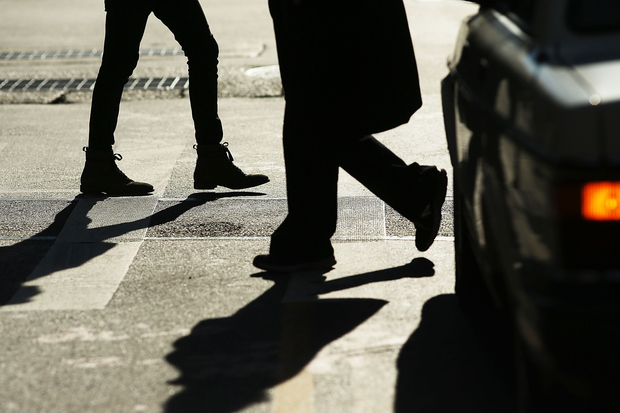Historically in America, towns and cities were built on a framework of walking. From center-city Boston to pioneer towns out west, people set up centralized areas for work, shopping, recreation, and living. As the automobile boomed, however, we began to systematically engineer walking out of daily life. In 1969, walking made up 40 percent of all trips in the U.S., in 2008 walking trips had dramatically decreased to 11 percent.
Today, the trend is shifting back. People of all ages are demanding to live in places that are walkable. Our aging population seeks walking as a way to improve health and to ensure access to goods and services so that they can age in place; younger generations want to live in urban areas with vibrant towns where cars are not necessary for daily travel.
In contrast to the “white flight” and decaying of central cities, today the most walkable places hold the highest real estate values, and were impacted least and rebounded quickest from our recent real estate crisis. Studies show that though real estate prices in these areas may be higher, these walkable places can actually be more affordable because of decreased transportation costs achieved by allowing families to get rid of one or more autos. The National Association of REALTORS even went so far to say that “Walkable Urban Places are the Future of Real Estate Development”.
Obvious Solutions
A critical factor to achieving walkable communities is to provide safe, accessible, and comfortable walking conditions. On the ground, this effectively means ensuring that people are prioritized over automobiles. Solutions include reducing speed limits, re-evaluating the speeds at which roadways are designed, and cracking down on distracted driving, speeding, red light running, and impaired driving. And in population centers, jurisdictions must reengineer streets to put people, families, and their mobility first.
The strategies may be straight forward, but they take political guts. Some solutions seem obvious, such as shifting the funding paradigm. For example, 11% of all transportation trips are on foot (and there are many more walking trips not counted as transportation) but only 1.5% of federal transportation funding goes to improve infrastructure for walking. And 14% of roadway fatalities are people walking, but barely 1% goes to improve their safety.
Urban Progress
Population centers are most urgently in need of change, as these areas are plagued with the highest rates of walking fatalities and need for transportation options. And, it’s these population centers that have responded the most effectively to making real progress and to drive the culture change needed shift urban planning.
In the U.S., New York City has led the way. Mayor Bloomberg’s administration worked to take back the public way for people on foot and bikes. It developed a robust public plaza program—like the signature Times Square plaza—for all people to enjoy, leveraged bikeway improvements to increase pedestrian safety, and took back underutilized pavement to put down seats in these newly created “places”. More recently, New York rolled out its Vision Zero campaign—a concept originated in Sweden to eliminate all traffic fatalities—to drive the political battle. Advocacy groups such as the group Families for Safe Streets, comprised of victims of traffic violence on New York City’s streets and their families, publically called for the end of roadway carnage. They have achieved political success, now propelling Mayor Bill de Blasio and the New York City Department of Transportation to launch their own ambitious Vision Zero campaign that includes 64 measures to eliminate traffic fatalities in the city.
Other cities around the nation have begun to leverage both social justice and economic development issues to reprioritize the public way from the auto to the people. San Francisco has both pioneered implementing parklets—taking auto parking spaces and turning them into mini urban parks—and using a data-driven approach to transform entire corridors of hazardous roadways into safe havens for people to walk and do their daily business. A recent spate of pedestrian fatalities and injuries in Columbia, Missouri has led their Mayor and City Council to prioritize pedestrian safety. These local efforts speak to the growing cry for safe streets that cater to pedestrians over automobiles.
Main Street
A next frontier of this battle is where state highways are blasting apart small towns and “main street” America. While main street businesses are beginning to realize that high speed multiple lane highways are bad for their once historic, quaint, business-focused streets, for conditions to truly change, federal and state Departments of Transportation must get on board and change their culture from a mission of the rapid movement of automobiles to the empowerment of communities, towns, and people..
America Walks and other transportation advocacy groups are working to change these cultures. We aim to cultivate local advocacy organizations and provide technical and strategy support on making real changes to communities. For example, America Walks leads a national coalition – the Every Body Walk! Collaborative – to support over 100 mostly national organizations to push walkability to their constituencies and beyond. We also target specific agencies, such as state transportation and health departments, to create solutions the increase walking across America.
The movement to increase walkable communities in the U.S. is still nascent, but the wind is our backs and now is the time to change cultures and environments.
Read more in this debate: Ralph Buehler, Katie Matchett, Klaus Bondam.
Source: The European
May 28, 2015
By Scott Bricker
http://www.theeuropean-magazine.com/scott-bricker/10183-walking-in-america











